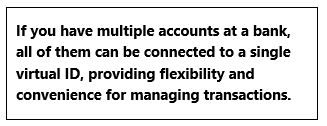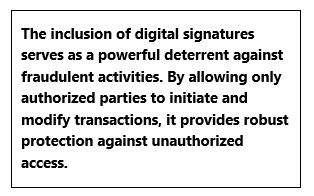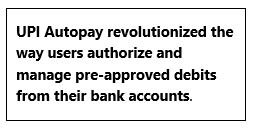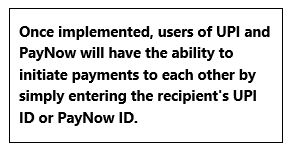Old dog, new tricks
Unless you have been dwelling in a cave, it’s impossible to escape the mighty Unified Payment Interface (UPI), India’s sensational real-time payment and money transfer option. Brought to you by the Reserve Bank of India (RBI) and the National Payments Corporation of India (NPCI), UPI has captured the hearts and wallets of millions across the nation, and how!
We’ve previously called UPI the trailblazer of [open banking initiatives] worldwide, and boy, were we right! Dilip Asbe, MD and CEO of NPCI, proudly boasts that UPI has one of the fastest adoption rates in the history of payment systems. The current statistics are equally mind-boggling. In fact, in April 2023 alone, UPI recorded a jaw-dropping 8.9 billion transactions worth a whopping ₹14 trillion (~$170B).
But hold on, UPI is back in the spotlight for a momentous reason. After nearly 7 years of UPI reigning supreme, the RBI dropped a bombshell announcement in April 2023. They are about to introduce a direct credit line on UPI! Now, let us take a step back and appreciate the significance of this move. In a country where a whopping 22% of the adult population is still unbanked (according to The Global Findex Database 2021), and many more are underbanked, this direct credit feature has the potential to ignite an economic explosion.
In this article, we are going to dive into the exciting realm of UPI and explore some of the cool stuff NPCI has already cooked up. And of course, we will discuss the latest showstopper on the list: the direct credit option.
Exponential Amplification: Breaking Barriers
In its early days, UPI experienced a slow start, as is typical with any ground-breaking technological innovation, as India gradually developed confidence in it as a secure payment method. After its launch, UPI took over a year to surpass 10 million monthly transactions, and over three and a half years to cross the 1 billion transaction mark. Since then, UPI has grown ninefold, achieving this impressive growth in approximately the same amount of time. Essentially, once UPI gained the trust of the Indian populace, it rapidly gained momentum and became a massive success.
Much of the success of UPI can be attributed to its core simplicity. All you got to do is choose a platform, set up a virtual ID for your bank account, and remember a transaction pin. Boom! You are ready to go. And guess what? If you and the recipient are using the same third-party platform, things get even easier. You can send money to their phone number without even needing that virtual ID. It’s like magic but without the smoke and mirrors. Furthermore, if you have multiple accounts at a bank, all of them can be connected to a single virtual ID, providing flexibility and convenience for managing transactions. The transactions are all real-time and can be initiated and processed at any time, providing round-the-clock accessibility to users.

After laying the foundations with the banks, NPCI stepped up its game by introducing its very own app called “BHIM” (Bharat Interface for Money), a streamlined and user-friendly tool designed to make UPI-based transactions a breeze for Indian users.
However, by that point, the floodgates of customer experience innovations had burst wide open. Banks and fintech companies joined forces, launching a relentless wave of cutting-edge advancements that transformed the user experience landscape. It was an era of rapid-fire innovations, where each player vied to outdo the other in delivering unprecedented convenience and delight to the users.
The UPI system was cleverly crafted to be all about mobiles, making the most of the smartphone revolution and the lightning-fast internet. It hitched a ride on the biometric security feature of those fancy smartphones, working its magic for the holy grail of 2Factor Authentication (2FA). And in this process, UPI managed to strike the perfect balance between security and a smooth, frictionless user experience. No security compromises, just pure convenience.
But the brilliant minds at NPCI were just getting started. They were not satisfied with resting on their laurels. Over the course of the past seven years, they unleashed a whirlwind of innovative features that blew the lid off the possibilities of the UPI ecosystem. It’s like a never-ending party of innovation and convenience, expanding the scope and skyrocketing the usage of UPI.
Products Galore: Multitude of Possibilities
UPI was built with the fundamental principles of introducing ease, speed, and interoperability in payments, at scale.
The QR Code
The quest for widespread adoption prompted the introduction of the QR Code, thus revolutionizing the payment landscape. With a mere scan of the QR code, customers could seamlessly complete transactions with merchants. Initially, QR code-based transactions on UPI relied on unique codes generated by individual payment service providers or UPI-enabled apps. Each provider had its own QR code format, necessitating users to scan the code using the corresponding app to initiate a payment.
Subsequently, to enhance interoperability and convenience across UPI-enabled apps and payment service providers, a Universal QR Code was launched. Today the merchant can be onboarded by any of the platforms that provide the QR code, but the payment can be initiated by the customer operating from any other platform.
QR Codes became a game-changer for small businesses in today’s digital economy, offering a cost-effective and user-friendly solution. It is safe to say that this humble innovation played a significant role in driving UPI’s popularity over the years. Interestingly, it also found its moment in the spotlight when the demand for cashless payments surged during the peak of the Covid season.
Recognizing the potential, NPCI took QR code payments to the next level by expanding their capabilities. Merchants were granted the ability to embed additional information within the QR codes, such as item details, invoice numbers, and transaction-specific data. This enhancement paved the way for smoother and more precise transactions, elevating the overall user experience.
Digital Signature
Building upon the foundation of multi-factor authentication, UPI took a leap forward in enhancing transaction security and reliability by introducing digital signatures. This innovative feature is aligned with the concept of public and private keys in cryptography. When a sender system digitally signs a transaction request, it involves the use of a digital signature algorithm, which relies on a pair of cryptographic keys: a private key and a corresponding public key.
The digital signature serves as proof of the authenticity and integrity of the transaction request. It ensures that the transaction has not been tampered with and can be verified using the corresponding public key.

The public key is available to the verifying party, which can be a participant bank or the UPI central infrastructure. The public key is used to verify the digital signature and confirm the authenticity and integrity of the transaction request. The inclusion of digital signatures serves as a powerful deterrent against fraudulent activities. By allowing only authorized parties to initiate and modify transactions, it provides robust protection against unauthorized access.
Recurring Payments

Introducing a hassle-free solution for recurring payments, UPI Autopay revolutionized the way users authorize and manage pre-approved debits from their bank accounts. This innovative feature allows users to establish a one-time authentication process for automatic payments.
With UPI Autopay, users can effortlessly link their bank accounts and set up instructions to authorize recurring payments at designated intervals. Whether it’s daily, weekly, monthly, or annually, users have the flexibility to specify the frequency of payments. Once the authorization is in place, the predetermined amounts are automatically debited from the user’s account on the specified dates, eliminating the need for any further action.
The applications for automated payments are extensive, covering a wide range of use cases. From utility bills and online subscriptions to loan EMIs and insurance premiums, UPI Autopay simplifies the payment process, ensuring timely and seamless transactions without the hassle of manual intervention.
Digital Invoice
UPI Invoice in the Inbox simplifies the process of generating, delivering, and managing invoices by leveraging the UPI infrastructure. It streamlines the billing and payment experience for businesses and customers. Customers can now receive the invoices directly on the UPI platform, swiftly review the itemized details, and initiate seamless payments without any hassle. The UPI-linked app keeps a record of received invoices in the inbox or notification section, ensuring easy access and reference whenever needed.
Small Business owners can now virtually integrate digital invoices, collect requests, and periodic reminders to make collections digitalized, automated, and significantly more efficient. hospitals and diagnostic centres can leverage this feature to share reports and observations through the collect request, providing patients with valuable contextual information.
One-time Mandates
The One-Time Mandate feature, released as part of the UPI 2.0 package, allowed users to set up one-time or recurring payments with a predefined validity period. This feature simplifies the payment process for various use cases such as rent, insurance premiums, and donations. It found wider use in the travel industry as mandates were used to book tickets, cabs, and hotel reservations for future-dated travel.
One of the excellent uses of mandates came in bidding for IPOs. Under Applications Supported by Blocked Amount (ASBA), investors can block the amount they want to invest in an IPO before the bidding process begins. This ensures that the investor has the funds available to pay for the shares if they are allotted. The investor creates a UPI mandate with their broker, which authorizes the broker to debit the investor’s bank account, if and when the IPO is allotted.
Cross-Border Payments
With dreams of expanding its reach beyond borders, UPI has always been forward-thinking. One of its initial endeavours was the introduction of Foreign Inward Remittance, enabling users to receive funds effortlessly and securely from overseas into their UPI-linked bank accounts.
The latest endeavour ups the ante by quite a few notches.
In India, UPI stands tall as a leading real-time payment system, while in Singapore, PayNow takes the spotlight. Recognizing the potential for collaboration, the National Payments Corporation of India (NPCI) and the Monetary Authority of Singapore (MAS) joined forces in February 2023. They inked a memorandum of understanding (MoU) to link UPI with PayNow, creating an exciting partnership between two prominent real-time payment systems.
This groundbreaking alliance will enable users of UPI and PayNow to engage in instant and cost-effective cross-border transactions, regardless of their location. The mechanism facilitating this seamless connection is known as the Cross-Border Interoperable Payment System (CBIPS). CBIPS acts as a platform, facilitating connectivity between banks and financial institutions, allowing them to exchange payments across borders.
The NPCI and MAS have expressed their intent to make CBIPS operational by the end of 2023. Once implemented, users of UPI and PayNow will have the ability to initiate payments to each other by simply entering the recipient’s UPI ID or PayNow ID. The system will then process the payment and transfer funds instantly, providing a swift and efficient cross-border payment experience.

The NPCI and MAS have expressed their intent to make CBIPS operational by the end of 2023. Once implemented, users of UPI and PayNow will have the ability to initiate payments to each other by simply entering the recipient’s UPI ID or PayNow ID. The system will then process the payment and transfer funds instantly, providing a swift and efficient cross-border payment experience.
An additional advantage of utilizing CBIPS for international transactions is the expected low transaction fee, making it a cost-effective method for sending money across borders. This development opens up new avenues for seamless cross-border financial interactions, further strengthening the ties between India and Singapore.
Rounding off
UPI boasts numerous noteworthy features and functionalities that cater to diverse user needs. For instance, recognizing the importance of serving the Non-Resident Indian (NRI) community, UPI has expanded its reach to accommodate foreign phone numbers linked to NRE or NRO accounts. This extension ensures that NRIs can seamlessly utilize UPI services, even with their international phone numbers.
UPI expanded its reach beyond smartphones with the introduction of UPI 123Pay, enabling payments without the need for a smartphone. This innovative method operates by initiating payments through missed calls or SMS sent to a designated short code. Users simply need to enter the desired payment amount and their UPI PIN. Subsequently, the payment is processed seamlessly.
UPI Aadhaar Pay presents a convenient feature that empowers users to effortlessly make payments utilizing their Aadhaar number. This functionality operates by establishing a secure link between the user’s Aadhaar number and their bank account. To initiate a payment, the user simply needs to enter the desired payment amount along with their Aadhaar number. Subsequently, the payment is securely processed, ensuring a seamless transaction experience.
UPI has successfully captured the attention of Millennials and Gen Z by introducing a captivating feature: the ability to split bills among multiple users. This functionality makes it incredibly convenient to divide expenses and settle payments among friends, colleagues, or groups. With the option to split bills, UPI appeals to the younger generations, providing them with an effortless way to manage shared expenses and ensure fair financial dealings.
Innovative additions like these further enhance the versatility and appeal of UPI, making it a preferred choice for a wide range of users with varying requirements and preferences. UPI continues to evolve, adapting to changing demands and delivering an exceptional payment experience to its ever-growing user base.
Unleashing the Magic of Credit
Credit, the currency of trust in the economic ecosystem, holds immense significance for both businesses and individuals. Credit lines serve as the lifeblood that fuels business growth, while for individuals, they serve as a catalyst for aspirations.
Back in 2018, UPI introduced a credit feature on its platform, allowing customers to link their bank overdraft accounts for quick access to loans. However, this plan encountered obstacles and fell short of expectations. The charges associated with the feature dampened merchant enthusiasm, leading to its untimely demise.
However, credit made a grand comeback on UPI, this time with a clever twist—linking credit cards to the platform. This simple yet ingenious move addressed the challenges faced by small merchants when it came to card payments. Traditional card payments required clunky point-of-sale (POS) machines, which were an infrastructure headache. Moreover, credit card transactions imposed hefty fees on merchants. UPI tackled both these issues brilliantly. Credit on UPI eliminated the need for POS infrastructure and even rendered physical cards obsolete. Additionally, thanks to the homegrown RuPay card’s competitive edge against Visa and Mastercard, it enjoyed certain advantages. To top it off, transactions below ₹2,000 incurred no fees, resulting in substantial savings.
While Visa and Mastercard still carry high charges, merchants have the choice to accept RuPay cards, making this scheme a resounding success. Of course, Visa and Mastercard still have high charges, and banks are eager to push them for monetization, but merchants can only choose to accept RuPay cards. So, this scheme worked, and how.
And now, we come to the crux of the matter—the imminent introduction of direct credit on UPI. This time, it is not about linking a credit card but obtaining a straightforward loan from a bank for payments on UPI apps.
What is the big deal, you may wonder? Well, picture this: even without a credit card, you could secure a short-term loan for UPI transactions. Banks can bid farewell to the worries, costs, and hassles of issuing physical credit cards. Instead, they can assign you a pre-approved loan limit based on your relationship with them or through data analytics to assess your creditworthiness. When you’re ready to make a credit-based purchase, you can utilize that loan, all without the need for expensive swipe machines. A good old QR code will suffice.
The big question is whether banks can effectively monetize this endeavour. In the past, when they attempted to monetize the overdraft facility, they faced limited success. However, the landscape has changed significantly since then, with UPI becoming far more ubiquitous. Additionally, with the growing normalization of Buy Now, Pay Later (BNPL) services, merchants may be more receptive to associated charges. Only time will tell.
But what implications would this have for credit cards if the direct credit approach gains traction? Two points warrant consideration:
Firstly, high spenders cherish the rewards and features that credit cards offer, including redeemable points at various establishments. These extras are not typically associated with a loan-based approach. Credit card companies can afford to provide these rewards “free” because they generate revenue from merchants when cards are swiped. It seems unlikely that banks would be able to offer such rewards on direct credit, given the wafer-thin margins.
Secondly, credit cards provide higher limits and are preferred for significantly large purchases. Unless the credit limits offered through UPI are sufficiently high, individuals may still rely on credit cards for such high-value transactions.
The unfolding of events will provide clarity on how this landscape evolves. However, one thing is certain: UPI is here to stay, and it never ceases to surprise us.
RS Software takes great pride in the opportunity to plan, design, construct, and deliver India’s Unified Payments Interface (UPI), which is the most advanced real-time payment system of the third generation worldwide.
After the successful implementation of UPI, RS Software has further collaborated with NPCI to provide the Bharat Billing Payment Solutions (BBPS), an exceptional online platform for electronic bill presentation and payments in India. Additionally, RS Software has developed the cutting-edge Enterprise Risk Fraud Management (EFRM) leveraging RS Software’s product RS IntelliEdge™ that safeguards India’s payment ecosystem from fraudulent activities.
RS Software’s expertise and visionary guidance have been instrumental throughout this remarkable journey while building the digital payment stack of India, earning the trust and confidence of NPCI.

Leave a Reply